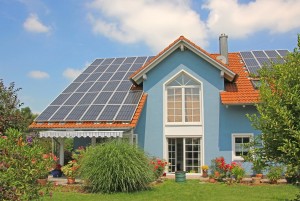
As long as your home’s energy efficiency is successfully reflected in your utility bills (and can be demonstrated to your potential buyer), there’s not really any need for the LEED stamp of approval.
Before you buy an energy-efficient home, what should you look for? Environmentally-friendly building standards can be a guide, but it can be difficult to understand what they really tell you. LEED, Passivhaus, net zero — you’ve heard these terms bandied about. What’s the difference between them? Here’s a quick guide to three of the most commonly used green building standards.
LEED
Created by the US Green Building Council, “LEED” stands for Leadership in Energy and Environmental Design and is probably the most widely known and commonly used green design standard in the United States. LEED is a points-based system, and a building can attain the level of LEED Certified, Silver, Gold, or Platinum (the highest possible rating).
A building earns points not only for the use of sustainable materials and energy-saving strategies, but also for the construction process, waste management, and building maintenance. LEED covers five categories of building design; one is specifically for single-family homes.
In a home, you can earn points for a wide range of sustainable features:
- LED lights
- low-VOC (volatile organic compound) or no-VOC paints and carpets
- cork and bamboo flooring
- low-flush toilets
- graywater treatment systems
- Energy Star appliances (although some experts argue that this rating should focus on overall consumption and not efficiency, due to large variations in appliance size)
- photovoltaic arrays
- water-efficient landscaping
- energy-efficient boilers
…and the list goes on. The most high-performance, energy-saving materials (which can be more expensive) and strategies will earn you the most points, but you also have to pay for the LEED verification process and the certification—which is why many homeowners don’t care to get certified. You can, of course, use the LEED standards as a guideline for building or buying your home.
But as long as you know your home is energy efficient, and this is successfully reflected in your utility bills (and can be demonstrated to your potential buyer), there’s not really any need for the LEED stamp of approval.
Net Zero Energy
Net zero energy is a more focused green building standard than LEED, with the straightforward aim of reducing energy consumption, which translates to reduced carbon emissions and less dependence on fossil fuels. That’s a pretty good idea, considering that homes consume 37 percent of the United States’ electricity production.
A net zero energy home essentially produces all of the energy it consumes (and maybe more) on-site through a renewable energy system: either photovoltaic panels or a wind turbine or a combination of both. Of course, these can be expensive systems to install, but costs are slowly coming down, there are federal tax credits available to cut down the costs, and your ROI will be quite dramatic.
If the house is a super-duper energy source, producing a lot more electricity than it consumes, the surplus electricity can be sold right back to the grid. In this case, the house is called “grid positive,” although some net zero homes are simply “off the grid” due to their energy independence. The key to creating a net zero energy building is to first minimize energy consumption with energy-efficient design (mechanical systems, lots of daylighting, etc.).
Passivhaus
It’d be an enormous understatement to say that Passivhaus (also written as Passive House) design also narrows in on energy efficiency. What’s so cool about Passivhaus? How about a drop in energy consumption of up to 90 percent? You just can’t do any better than this, unless you lived on a deserted island. Aside from superior indoor air quality, lack of noise pollution, and overall increased indoor comfort, your energy bill would be equivalent to the cost of running a hair dryer, as the Passivhaus experts like to say.
But how in the world is that possible? These incredibly high-performance buildings differ from net zero energy buildings because they focus solely on design, instead of renewable energy systems or high-performance mechanical systems. If you have a supertight, well-insulated building shell, you won’t actually need an HVAC system! And that means your doors and windows don’t leak air (inefficient windows can cost you $700 a year in energy costs), and you have the highest R-values possible in the roof and walls. Also important is the orientation of the house according to the direction of the sun.
Passivhaus is probably the least well-known eco-standard — in the United States, that is. This ultra-energy-efficient approach has been popular for several decades in Europe, where you’ll find more than 30,000 certified buildings, versus 100 certified buildings in the U.S. — although that doesn’t take into account uncertified Passivhaus buildings, many of which are homes.
The reason Passivhaus hasn’t taken over the U.S. construction industry is partly due to lack of awareness and partly to the cost of the needed high-performance materials, some of which aren’t yet manufactured in the U.S. But that’s quickly changing as awareness of this über-strict design grows, and more savvy architects across the country have been able to demonstrate that Passivhaus is definitely within reach for the average homeowner.
What about you — would the energy efficiency of a for-sale home affect your decision making?

